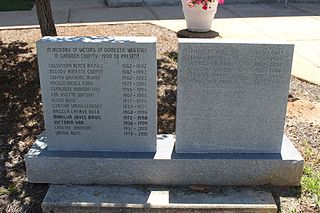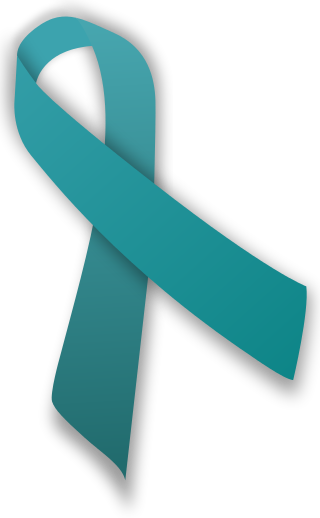
Victimology is the study of victimization, including the psychological effects on victims, the relationship between victims and offenders, the interactions between victims and the criminal justice system—that is, the police and courts, and corrections officials—and the connections between victims and other social groups and institutions, such as the media, businesses, and social movements.
Sexual assault is an act in which one intentionally sexually touches another person without that person's consent, or coerces or physically forces a person to engage in a sexual act against their will. It is a form of sexual violence that includes child sexual abuse, groping, rape, drug facilitated sexual assault, and the torture of the person in a sexual manner.
Some victims of rape or other sexual violence incidents are male. It is estimated that approximately one in six men experienced sexual abuse during childhood. Historically, rape was thought to be, and defined as, a crime committed solely against females. This belief is still held in some parts of the world, but rape of males is now commonly criminalized and has been subject to more discussion than in the past.
Victim blaming occurs when the victim of a crime or any wrongful act is held entirely or partially at fault for the harm that befell them. There is historical and current prejudice against the victims of domestic violence and sex crimes, such as the greater tendency to blame victims of rape than victims of robbery if victims and perpetrators knew each other prior to the commission of the crime. The Gay Panic Defense has also been used to justify violence against LGBT people.
Articles related to criminology and law enforcement.

The Violence Against Women Act of 1994 (VAWA) is a United States federal law signed by President Bill Clinton on September 13, 1994. The Act provided $1.6 billion toward investigation and the prosecution of violent crimes against women, imposed automatic and mandatory restitution on those convicted, and allowed civil redress when prosecutors chose to not prosecute cases. The Act also established the Office on Violence Against Women within the U.S. Department of Justice.
Native American women encounter a disproportionate level of sexual violence from verbal abuse to physical harm, including but not limited to domestic and sexual assaults. Such violations not only result in lasting detrimental effects on the individuals subjected to them but also reverberate throughout their entire community, exacerbating social challenges.
Rape is a traumatic experience that affects the victim (survivor) in a physical, psychological, and sociological way. Even though the effects and aftermath of rape differ among victims, individuals tend to suffer from similar issues found within these three categories. Long-term reactions may involve the development of coping mechanisms that will either benefit the victim, such as social support, or inhibit their recovery. Seeking support and professional resources may assist the victim in numerous ways.
Domestic violence occurs across the world, in various cultures, and affects people across society, at all levels of economic status; however, indicators of lower socioeconomic status have been shown to be risk factors for higher levels of domestic violence in several studies. In the United States, according to the Bureau of Justice Statistics in 1995, women reported a six times greater rate of intimate partner violence than men. However, studies have found that men are much less likely to report victimization in these situations.
Intimate partner sexual violence (IPSV) deals with sexual violence within the context of domestic violence. Intimate partner sexual violence is defined by any unwanted sexual contact or activity by an intimate partner in order to control an individual through fear, threats, or violence. Women are the primary victims of this type of violence.
Victimisation is the state or process of being victimised or becoming a victim. The field that studies the process, rates, incidence, effects, and prevalence of victimisation is called victimology.
Specialized domestic violence courts are designed to improve victim safety and enhance defendant accountability. There is no one set definition of a specialized violence court, although these types of courts can be either civil or criminal and typically hear the majority of an area's domestic violence cases on a separate calendar. Additionally, these courts are typically led by specially assigned judges who can make more informed and consistent decisions based on their expertise and experience with the unique legal and personal issues in domestic violence cases.

The National Sexual Violence Resource Center (NSVRC) is an American nonprofit organization that addresses the causes and impact of sexual violence through collaboration, prevention, and resources. Working in collaboration with state and territory sexual assault coalitions, representatives from underserved populations, the Centers for Disease Control and Prevention, the U.S. Department of Justice's Office on Violence Against Women, and a host of community-based and national allied projects, NSVRC provides national leadership to address and prevent sexual violence.
Victims' rights are legal rights afforded to victims of crime. These may include the right to restitution, the right to a victims' advocate, the right not to be excluded from criminal justice proceedings, and the right to speak at criminal justice proceedings.

Domestic violence is a form of violence that occurs within a domestic relationship. Although domestic violence often occurs between partners in the context of an intimate relationship, it may also describe other household violence, such as violence against a child, by a child against a parent or violence between siblings in the same household. In the United States, it is recognized as an important social problem by governmental and non-governmental agencies, and various Violence Against Women Acts have been passed by the US Congress in an attempt to stem this tide.
Violence against men are violent acts that are disproportionately or exclusively committed against men or boys. Men are over-represented as both victims and perpetrators of violence.

Safe Horizon, formerly the Victim Services Agency, is the largest victim services nonprofit organization in the United States, providing social services for victims of abuse and violent crime. Operating at 57 locations throughout the five boroughs of New York City. Safe Horizon provides social services to over 250,000 victims of violent crime and abuse and their families per year. It has over 800 employees, and has programs for victims of domestic violence, child abuse, sexual assault, and human trafficking, as well as homeless youth and the families of homicide victims. Safe Horizon's website has been accessible for the Spanish-speaking population since 2012. Safe Horizon has an annual budget of over $63 million.
The feminist pathways perspective is a feminist perspective of criminology which suggests victimization throughout the life course is a key risk factor for women's entry into offending.

Sexual assault of LGBT people, also known as sexual and gender minorities (SGM), is a form of violence that occurs within the LGBT community. While sexual assault and other forms of interpersonal violence can occur in all forms of relationships, it is found that sexual minorities experience it at rates that are equal to or higher than their heterosexual counterparts. There is a lack of research on this specific problem for the LGBT population as a whole, but there does exist a substantial amount of research on college LGBT students who have experienced sexual assault and sexual harassment.
Secondary victimisation refers to further victim-blaming from criminal justice authorities following a report of an original victimisation.





